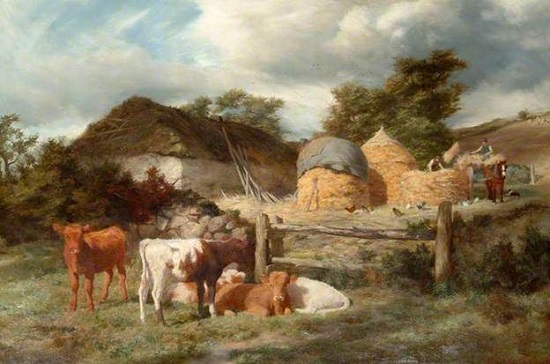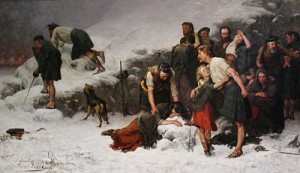Chi partiva per sfuggire alla miseria esprimeva il suo dolore nelle canzoni, il carico di rimpianti e l’addio alle persone care lasciate a casa, misto a volte all’eccitazione per l’avventura; cantavano mestamente o pieni di rancore, anche i condannati alla deportazione nelle colonie d’Australia o Nuova Zelanda, condannati dalla sommaria e severa legge inglese.
Those who left to escape poverty expressed their pain in the songs, the load of regrets and the farewell to loved ones left at home, sometimes mixed with excitement for adventure; they sang sadly or full of rancor, even those condemned to deportation to the colonies of Australia or New Zealand, condemned by the summary and strict English law.
ARCHIVIO IRLANDA E IRLANDA DEL NORD
(ARCHIVE IRELAND AND NORTHERN IRELAND)
AIRDÍ CUAN
Across the Western Ocean (sea shanty)
BALLINDERRY
BANKS OF NEWFOUNDLAND
BOYS OF MULLAGHBAWN
(A) chomaraigh aoibhinn ó (Sweet Comeragh)
CLIFFS OF DOONEEN
CRAIGIE HILL
Erin grá mo chroí
FAREWELL MY LOVE AND REMEBRE ME
FAREWELL TO BALLYMONEY
FAREWELL TO OLD IRELAND
GALWAY BAY
GREEN FIELDS OF AMERICAY
GREEN FIELDS OF GAOTH DOBHAIR
GREEN GLENS OF GWEEDORE
(The) Irish Emigrant (sea shanty)
(The) Irish Girl of Mr Tapscott
ISLE OF INNISFREE
KILKELLY,IRELAND
Love is pleasing
MAID OF CULMORE
(A) man’s in love
MOLLY MAGUIRES
MOUNTAINS OF MOURNE
My Own Dear Galway Bay
OLD CROSS ARDBOE
Paddy’s Green Shamrock Shore
PADDY WORKS ON THE RAILWAY
Red is the Rose
SHAMROCK SHORE
SKIBBEREEN
SPANCIL HILL
STÓR MO CHROÍ
STREAMS OF BUNCLODY
STREETS OF NEW YORK
Tho’ the last glimpse of Erin
We Want No Irish Here
CANTI SCOZZESI
BACK OF BENNACHIEERIN GO BRAGH
Dùthaich Mhic Aoidh
FAREWELL TO FIUNARY
FAREWELL TO THE BANKS OF AYR
Lochaber no more
Ó MO DHÙTHAICH
AMERICA
Across the Western Ocean (sea shanty)
Erin grá mo chroí
(The) Irish Emigrant (sea shanty)
(The) Irish Girl of Mr Tapscott (sea shanty)
NEW YORK GALS (sea shanty)
PADDY WORKS ON THE RAILWAY
SIDEWALKS OF NEW YORK
STREETS OF NEW YORK
We Want No Irish Here
AUSTRALIA
BOTANY BAY
BOUND FOR BOTANY BAY
BOUND TO AUSTRALIA
BOYS OF MULLAGHBAWN
FIELDS OF ATHENRY
JAMIE RAEBURN
MORETON BAY
SHORES OF BOTANY BAY
VAN DIEMEN’S LAND
CELTIC CANADA
AN INNIS AIGH
BANKS OF NEWFOUNDLAND
PIEMONTE
MALEDIZIONE DELLA MADRE (Mamma mia dammi cento lire) (Nigra #23)
HIGHLAND CLEARANCES
“Gli sgombri delle Highlands” (che non sono un tipo di pesce) furono il trasloco forzoso (epurazione) degli abitanti delle Highlands ovvero dei contadini, che lavoravano la terra di un laird ed erano da secolo legati a patti di sangue e legami famigliari con i clan e che si videro sgretolare (da sotto i piedi o meglio letteralmente da sopra la testa) tale struttura.
Al posto dei campi coltivati i proprietari preferirono barattare i propri coloni con capi ovini per trasformare le terre coltivate in pascolo e destinare le loro tenute alle battute di caccia.
I tempi stavano cambiando e nelle Lowlands era incominciata la rivoluzione industriale…

Le Clearences si sviluppano grossomodo tra il 1750 e il 1880, in alcuni casi si trattava di interi villaggi che scomparivano con i loro abitanti condotti ai porti e imbarcati in massa per emigrare in America o Australia oppure per fornire la mano d’opera al nuovo sistema di valori generato dall’industrializzazione. Il governo inglese definì le clearance come una sorta di ammodernamento e razionalizzazione delle risorse produttive del Nord e una risposta al sovrappopolamento delle Highlands.. un esodo così massiccio che ancora oggi ha lasciato la Scozia scarsamente popolata.
Se la maggior parte degli Scozzesi finirono per lasciare la loro terra senza reagire occasionalmente nascevano delle rivolte in cui venivano sgozzate le pecore mandate a pascolare, prontamente stroncate nel sangue; la più significativa di queste ribellioni fu quella del 1792 nella conta di Ross, guidata da Alasdair Wallace.
Nell’Ottocento così li sgomberi si fecero più brutali: squadre armate passavano a incendiare case e fattorie, chi si opponeva veniva arrestato o bruciato vivo nella propria casa.
Per quanto non ci siano delle cifre ufficiali si stima che nel Settecento emigrarono per le terre d’oltre mare 70.000 highlanders, una cifra simile fu quella degli emigranti tra il 1800 e il 1860; in questi grandi numeri non si comprendono però i movimenti interni ossia gli abitanti che furono costretti ad andare a vivere sulla costa o nelle grandi città.
Il nocciolo della questione è il cambiamento di una mentalità o la fine di un epoca quella in cui la terra era un bene comune e il capo-clan un amministratore di tale bene, un uomo forte e intelligente, ma anche compassionevole e giusto che guidava il clan nelle alleanze e nelle guerre e applicava la legge dirimendo le controversie. Ad un certo punto la gerarchia si scollega al sistema di valori e i suoi vertici diventano lord e laird ossia proprietari terrieri in senso utilitaristico.
APPROFONDIMENTO
Dùthaich Mhic Aoidh (La Terra dei MacKay)
The Clearances were the forced removal (purge) of the Highlands inhabitants (expecially from countryside), who worked the land of a laird with secular blood pacts and family ties with the clans and who saw themselves crumble their home.
In place of the cultivated fields the landlords preferred to exchange their colonists with sheep heads to transform the lands cultivated in pasture and to allocate their estates at hunting trips. Times were changing and the industrial revolution had begun in the Lowlands …

The Clearences develop roughly between 1750 and 1880, in some cases it was entire villages that disappeared with their inhabitants led to ports and embarked en masse to emigrate to America or Australia or to provide the workforce to the new system of values generated by industrialization. The British government defined the clearances as a sort of modernization and rationalization of the productive resources of the North and a response to the overpopulation of the Highlands … a massive exodus that has left Scotland with little population.
If most of the Scots ended up leaving their land without reacting occasionally, there were riots, promptly cut off in the blood, in which the sheep were slaughtered; the most significant of these rebellions was that of 1792 in county Ross, led by Alasdair Wallace. In the nineteenth century, so the evictions became more brutal: armed teams went to burn houses and farms, those who opposed were arrested or burned alive in their home.
Although there are no official figures, it is estimated that in the eighteenth century 70,000 highlanders emigrated to overseas lands, a similar figure was that of emigrants between 1800 and 1860; in these large numbers we do not understand the internal movements, that is the inhabitants who were forced to go living on the coast or in the big cities.
The crux of the matter is the change of a mentality or the end of an era when the earth was a common good and the head-clan an administrator of that good, a strong and intelligent man, but also compassionate that guided the clan in alliances and wars and applied the law by settling disputes. At a certain point the hierarchy is disconnected from the value system and its vertices become landowners in a utilitarian sense.
